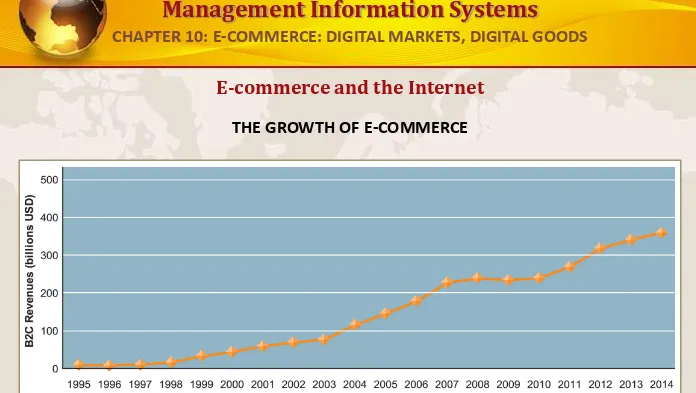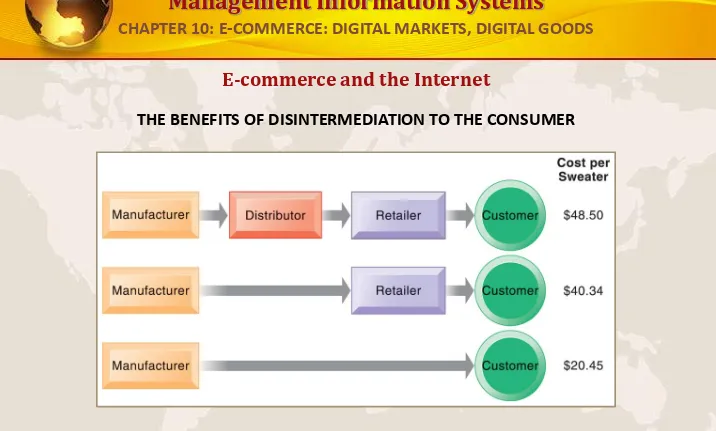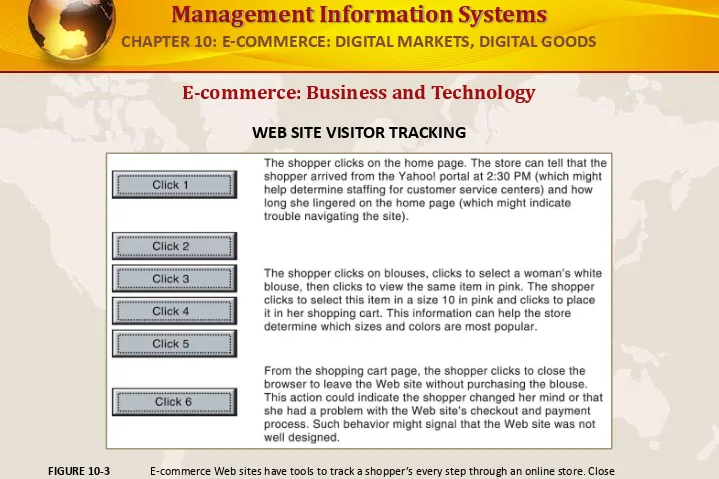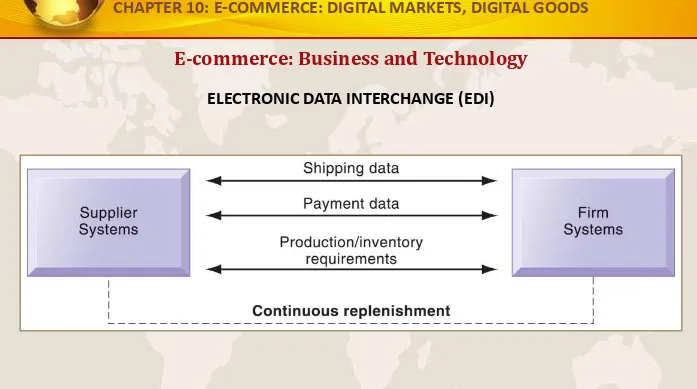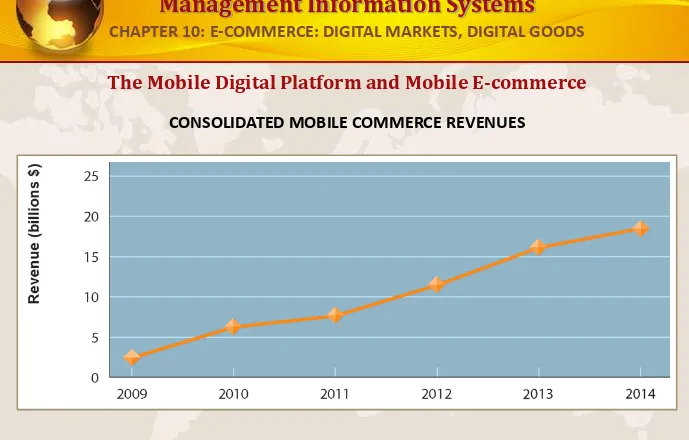Management Information Systems
MANAGING THE DIGITAL FIRM, 12THEDITION GLOBAL EDITION
E-COMMERCE: DIGITAL MARKETS,
DIGITAL GOODS
Chapter 10
VIDEO CASES
Management Information Systems
• What are the unique features of e-commerce, digital markets, and digital goods?
• What are the principal e-commerce business and revenue models?
• How has e-commerce transformed marketing?
• How has e-commerce affected business-to-business transactions?
• What is the role of m-commerce in business and what are the most important m-commerce applications?
• What issues must be addressed when building an e-commerce Web site?
Learning Objectives
Management Information Systems
•
Problem
-
Differentiate a burger restaurant’s
services in crowded marketplace (Manhattan)
•
Solution
–
Utilize social networking and
crowdsourcing for marketing and services
– Ordering via iPad, online
– Customers can create and name own sandwiches
– Twitter, Facebook, Foursquare integration
•
Illustrates:
Use of information systems to create
new products and services
•
Demonstrates:
Use of social networking
technologies as marketing tool
4FOOD: Burgers Go Social
Management Information Systems
•
E-commerce today:
–
Use of the Internet and Web to transact
business; digitally enabled transactions
–
Began in 1995 and grew exponentially, still
growing even in a recession
–
Companies that survived the dot-com bubble
burst and now thrive
–
E-commerce revolution is still in its early
stages
E-commerce and the Internet
Management Information Systems
E-commerce and the Internet
THE GROWTH OF E-COMMERCE
Retail e-commerce revenues grew 15–25 percent per year until the recession of 2008–2009, when they slowed measurably. In 2010, e-commerce revenues are growing again at an estimated 12 percent annually.
FIGURE 10-1
Management Information Systems
•
Why e-commerce is different
–
8 unique features
1. Ubiquity
•
Internet/Web technology available everywhere:
work, home, etc., anytime.
•
Effect:
– Marketplace removed from temporal, geographic
locations to become “marketspace”
– Enhanced customer convenience and reduced shopping costs
E-commerce and the Internet
Management Information Systems
•
8 unique features (cont.)
2. Global reach
•
The technology reaches across national
boundaries, around Earth
•
Effect:
– Commerce enabled across cultural and national boundaries seamlessly and without modification
– Marketspace includes, potentially, billions of
consumers and millions of businesses worldwide E-commerce and the Internet
Management Information Systems
•
8 unique features (cont.)
3. Universal standards
•
One set of technology standards: Internet
standards
•
Effect:
– Disparate computer systems easily communicate with each other
– Lower market entry costs—costs merchants must pay to bring goods to market
– Lower consumers’ search costs—effort required to find
E-commerce and the Internet
Management Information Systems
•
8 unique features (cont.)
4. Richness
•
Supports video, audio, and text messages
•
Effect:
– Possible to deliver rich messages with text, audio, and video simultaneously to large numbers of
people
– Video, audio, and text marketing messages can be integrated into single marketing message and
consumer experience
E-commerce and the Internet
Management Information Systems
•
8 unique features (cont.)
5. Interactivity
•
The technology works through interaction with
the user
•
Effect:
– Consumers engaged in dialog that dynamically adjusts experience to the individual
– Consumer becomes co-participant in process of delivering goods to market
E-commerce and the Internet
Management Information Systems
•
8 unique features (cont.)
6. Information density
•
Large increases in information density
—
the
total amount and quality of information
available to all market participants
•
Effect:
– Greater price transparency
– Greater cost transparency
– Enables merchants to engage in price discrimination E-commerce and the Internet
Management Information Systems
•
8 unique features (cont.)
7. Personalization/Customization
•
Technology permits modification of messages,
goods
•
Effect
– Personalized messages can be sent to individuals as well as groups
– Products and services can be customized to individual preferences
E-commerce and the Internet
Management Information Systems
•
8 unique features (cont.)
8. Social technology
•
The technology promotes user content
generation and social networking
•
Effect
– New Internet social and business models enable user content creation and distribution, and support social networks
E-commerce and the Internet
Management Information Systems
•
Key concepts in e-commerce
–
Digital markets reduce
• Information asymmetry
• Search costs
• Transaction costs
• Menu costs
–
Digital markets enable
• Price discrimination
• Dynamic pricing
• Disintermediation
E-commerce and the Internet
Management Information Systems
E-commerce and the Internet
THE BENEFITS OF DISINTERMEDIATION TO THE CONSUMER
The typical distribution channel has several intermediary layers, each of which adds to the final cost of a product, such as a sweater. Removing layers lowers the final cost to the consumer.
FIGURE 10-2
Management Information Systems
•
Key concepts in e-commerce
–
Digital goods
• Goods that can be delivered over a digital network
– E.g. Music tracks, video, software, newspapers, books
• Cost of producing first unit almost entire cost of product: marginal cost of 2nd unit is about zero
• Costs of delivery over the Internet very low
• Marketing costs remain the same; pricing highly variable
• Industries with digital goods are undergoing
revolutionary changes (publishers, record labels, etc.) E-commerce and the Internet
Management Information Systems
•
Types of e-commerce
•
Business-to-consumer (B2C)
•
Business-to-business (B2B)
•
Consumer-to-consumer (C2C)
•
Mobile commerce (m-commerce)
E-commerce: Business and Technology
Management Information Systems
•
E-commerce business models
–
Portal
–
E-tailer
–
Content Provider
–
Transaction Broker
–
Market Creator
–
Service Provider
–
Community Provider
E-commerce: Business and Technology
Management Information Systems
Read the Interactive Session and discuss the following questions
• Based on your reading in this chapter, how would you
characterize O2’s business model?
• If O2 is to have a revenue model, which of the revenue models described in this chapter would work?
• What considerations do O2 need to make when targeting potential customers?
• What other types of businesses might benefit from this type of location-based marketing?
E-commerce: Business and Technology
LOCATION-BASED MARKETING AND ADVERTISING
Management Information Systems
•
E-commerce revenue models
1. Advertising
2. Sales
3. Subscription
4. Free/Freemium
5. Transaction Fee
6. Affiliate
E-commerce: Business and Technology
Management Information Systems
•
Most popular Web 2.0 service: social networking
– Social networking sites sell banner ads, user preference information, and music, videos and e-books
•
Social shopping sites
– Swap shopping ideas with friends (Kaboodle, ThisNext)
•
Wisdom of crowds/crowdsourcing
– Large numbers of people can make better decisions about topics and products than a single person
•
Prediction markets:
– Peer-to-peer betting markets on specific outcomes (elections, sales figures, designs for new products)
E-commerce: Business and Technology
Management Information Systems
Read the Interactive Session and discuss the following questions
• What concepts in the chapter are illustrated in this case?
• Describe the weaknesses of Facebook’s privacy policies and
features. What management, organization, and technology factors have contributed to those weaknesses?
• List and describe some of the options that Facebook managers have in balancing privacy and profitability. How can Facebook better safeguard user privacy? What would be the impact on its profitability and business model?
• Do you anticipate that Facebook will be successful in developing a business model that monetizes their site traffic? Why or why not?
E-commerce: Business and Technology
FACEBOOK: MANAGING YOUR PRIVACY FOR THEIR PROFIT
Management Information Systems
•
E-commerce marketing
–
Internet provides marketers with new ways of
identifying and communicating with customers
–
Long tail marketing:
Ability to reach a large
audience inexpensively
–
Behavioral targeting:
Tracking online behavior of
individuals on thousands of Web sites
–
Advertising formats include search engine
marketing, display ads, rich media, and e-mail
E-commerce: Business and Technology
Management Information Systems
E-commerce: Business and Technology
WEB SITE VISITOR TRACKING
E-commerce Web sites have tools to track a shopper’s every step through an online store. Close
FIGURE 10-3
Management Information Systems
E-commerce: Business and Technology
WEB SITE
PERSONALIZATION
Firms can create unique personalized Web pages that display content or ads for products or services of special interest to individual users, improving the customer experience and creating additional value.
FIGURE 10-4
Management Information Systems
E-commerce: Business and Technology
HOW AN
ADVERTISING NETWORK SUCH AS DOUBLECLICK WORKS
Advertising networks have become
controversial among privacy advocates because of their ability to track individual consumers across the Internet.
FIGURE 10-5
Management Information Systems
•
Business-to-business e-commerce
–
Electronic data interchange (EDI)
• Computer-to-computer exchange of standard transactions such as invoices, purchase orders
• Major industries have EDI standards that define structure and information fields of electronic documents for that industry
• More companies increasingly moving away from private networks to Internet for linking to other firms
– E.g. Procurement: Businesses can now use Internet to locate most low-cost supplier, search online catalogs of supplier products, negotiate with suppliers, place orders, etc.
E-commerce: Business and Technology
Management Information Systems
E-commerce: Business and Technology
ELECTRONIC DATA INTERCHANGE (EDI)
Companies use EDI to automate transactions for B2B e-commerce and continuous inventory replenishment. Suppliers can automatically send data about shipments to purchasing firms. The purchasing firms can use EDI to provide production and inventory requirements and payment data to suppliers.
FIGURE 10-6
Management Information Systems
•
Business-to-business e-commerce (cont.)
–
Private industrial networks (private exchanges)
• Large firm using extranet to link to its suppliers, distributors and other key business partners
• Owned by buyer
• Permits sharing of:
– Product design and development
– Marketing
– Production scheduling and inventory management
– Unstructured communication (graphics and e-mail) E-commerce: Business and Technology
Management Information Systems
E-commerce: Business and Technology
A PRIVATE INDUSTRIAL NETWORK
A private industrial network, also known as a private exchange, links a firm to its suppliers, distributors, and other key business partners for efficient supply chain
management and other collaborative commerce activities.
FIGURE 10-7
Management Information Systems
•
Business-to-business e-commerce (cont.)
–
Net marketplaces (e-hubs)
• Single market for many buyers and sellers
• Industry-owned or owned by independent intermediary
• Generate revenue from transaction fees, other services
• Use prices established through negotiation, auction, RFQs, or fixed prices
• May focus on direct or indirect goods
• May be vertical or horizontal marketplaces E-commerce: Business and Technology
Management Information Systems
E-commerce: Business and Technology
A NET
MARKETPLACE
Net marketplaces are online marketplaces where multiple buyers can purchase from multiple sellers.
FIGURE 10-8
Management Information Systems
•
Business-to-business e-commerce (cont.)
–
Exchanges
• Independently owned third-party Net marketplaces
• Connect thousands of suppliers and buyers for spot purchasing
• Typically provide vertical markets for direct goods for single industry (food, electronics)
• Proliferated during early years of e-commerce; many have failed
– Competitive bidding drove prices down and did not offer long-term relationships with buyers or services to make lowering prices worthwhile
E-commerce: Business and Technology
Management Information Systems
•
M-commerce
–
Although m-commerce represents small
fraction of total e-commerce transactions,
revenue has been steadily growing
•
Location-based services
•
Banking and financial services
•
Wireless advertising and retailing
•
Games and entertainment
The Mobile Digital Platform and Mobile E-commerce
Management Information Systems
The Mobile Digital Platform and Mobile E-commerce
CONSOLIDATED MOBILE COMMERCE REVENUES
Mobile e-commerce is the fastest growing type of B2C e-commerce although it represents only a small part of all e-commerce in 2010.
FIGURE 10-9
Management Information Systems
•
Assembling a team with the skills required to
make decisions about:
–
Technology
–
Site design
–
Social and information policies
–
Hardware, software, and telecommunications
infrastructure
•
Customer’s demands should drive the site’s
technology and design
Building an E-commerce Web Site
Management Information Systems
•
Business decisions drive the technology
–
not the
reverse
–
Business objectives
• Capabilities the site should have
• E.g. execute a transaction payment
–
System functionality
• Technological capability to achieve this objective
• E.g. a shopping cart or other payment system
–
Information requirements
• E.g. secure credit card clearing, multiple payment options
Building an E-commerce Web Site
Management Information Systems
•
Alternatives in building the Web site
–
Completely in-house
–
Mixed responsibility
–
Completely outsourced
•
Co-location
•
Web site budgets
–
Several thousand to millions / year
–
50% of a budget is system maintenance and
content creation
Building an E-commerce Web Site
Management Information Systems
The Mobile Digital Platform and Mobile E-commerce
CHOICES IN BUILDING AND HOSTING WEB SITES
You have a number of alternatives to consider when building and hosting an e-commerce site.
FIGURE 10-10
Management Information Systems
The Mobile Digital Platform and Mobile E-commerce
COMPONENTS OF A WEB SITE BUDGET
Management Information Systems
All rights reserved. No part of this publication may be reproduced, stored in a retrieval system, or transmitted, in any form or by any means, electronic, mechanical, photocopying, recording, or otherwise, without the
prior written permission of the publisher.
Printed in the United States of America.
Copyright © 2012 Pearson Education
